1. Card T, West J, Hubbard R, Logan RF. Hip fractures in patients with inflammatory bowel disease and their relationship to corticosteroid use: a population based cohort study. Gut. 2004; 53(2):251–255. PMID:
14724159.

2. Vestergaard P, Mosekilde L. Fracture risk in patients with celiac disease, Crohn’s disease, and ulcerative colitis: a nationwide follow-up study of 16,416 patients in Denmark. Am J Epidemiol. 2002; 156(1):1–10. PMID:
12076883.

3. van Staa TP, Cooper C, Brusse LS, Leufkens H, Javaid MK, Arden NK. Inflammatory bowel disease and the risk of fracture. Gastroenterology. 2003; 125(6):1591–1597. PMID:
14724810.

4. Kappelman MD, Galanko JA, Porter CQ, Sandler RS. Risk of diagnosed fractures in children with inflammatory bowel diseases. Inflamm Bowel Dis. 2011; 17(5):1125–1130. PMID:
20872833.

5. van Staa TP, Leufkens HG, Cooper C. The epidemiology of corticosteroid-induced osteoporosis: a meta-analysis. Osteoporos Int. 2002; 13(10):777–787. PMID:
12378366.

6. Ludvigsson JF, Mahl M, Sachs MC, Björk J, Michaelsson K, Ekbom A, et al. Fracture risk in patients with inflammatory bowel disease: a nationwide population-based cohort study from 1964 to 2014. Am J Gastroenterol. 2019; 114(2):291–304. PMID:
30730858.

7. Levin AD, Wadhera V, Leach ST, Woodhead HJ, Lemberg DA, Mendoza-Cruz AC, et al. Vitamin D deficiency in children with inflammatory bowel disease. Dig Dis Sci. 2011; 56(3):830–836. PMID:
21222159.

8. Metzger CE, Narayanan A, Zawieja DC, Bloomfield SA. Inflammatory bowel disease in a rodent model alters osteocyte protein levels controlling bone turnover. J Bone Miner Res. 2017; 32(4):802–813. PMID:
27796050.

9. Manolagas SC, Parfitt AM. What old means to bone. Trends Endocrinol Metab. 2010; 21(6):369–374. PMID:
20223679.

10. Segal JP, Htet HM, Limdi J, Hayee B. How to manage IBD in the ‘elderly’. Frontline Gastroenterol. 2020; 11(6):468–477. PMID:
33101625.

11. Goulding A. Risk factors for fractures in normally active children and adolescents. Med Sport Sci. 2007; 51:102–120. PMID:
17505122.

12. Farr JN, Melton LJ 3rd, Achenbach SJ, Atkinson EJ, Khosla S, Amin S. Fracture incidence and characteristics in young adults aged 18 to 49 years: a population-based study. J Bone Miner Res. 2017; 32(12):2347–2354. PMID:
28972667.

13. Wu F, Mason B, Horne A, Ames R, Clearwater J, Liu M, et al. Fractures between the ages of 20 and 50 years increase women’s risk of subsequent fractures. Arch Intern Med. 2002; 162(1):33–36. PMID:
11784217.

14. Ahn HJ, Kim YJ, Lee HS, Park JH, Hwang SW, Yang DH, et al. High risk of fractures within 7 years of diagnosis in Asian patients with inflammatory bowel diseases. Clin Gastroenterol Hepatol. 2022; 20(5):e1022–e1039. PMID:
34216823.

15. Lee J, Lee JS, Park SH, Shin SA, Kim K. Cohort profile: the National Health Insurance Service-National Sample Cohort (NHIS-NSC), South Korea. Int J Epidemiol. 2017; 46(2):e15. PMID:
26822938.

16. Song SO, Jung CH, Song YD, Park CY, Kwon HS, Cha BS, et al. Background and data configuration process of a nationwide population-based study using the Korean National Health Insurance system. Diabetes Metab J. 2014; 38(5):395–403. PMID:
25349827.

17. Lix LM, Azimaee M, Osman BA, Caetano P, Morin S, Metge C, et al. Osteoporosis-related fracture case definitions for population-based administrative data. BMC Public Health. 2012; 12(1):301. PMID:
22537071.

18. Jeong SM, Shin DW, Han K, Jung JH, Chun S, Jung HW, et al. Timed up-and-go test is a useful predictor of fracture incidence. Bone. 2019; 127:474–481. PMID:
31323429.

19. Yoo JE, Yoon JW, Park HE, Han K, Shin DW. Blood pressure variability and the risk of fracture: a nationwide cohort study. J Clin Endocrinol Metab. 2022; 107(4):e1488–e1500. PMID:
34850029.

20. Park S, Chun J, Han KD, Soh H, Kang EA, Lee HJ, et al. Dose-response relationship between cigarette smoking and risk of ulcerative colitis: a nationwide population-based study. J Gastroenterol. 2019; 54(10):881–890. PMID:
31093771.

21. Soh H, Chun J, Han K, Park S, Choi G, Kim J, et al. Increased risk of herpes zoster in young and metabolically healthy patients with inflammatory bowel disease: a nationwide population-based study. Gut Liver. 2019; 13(3):333–341. PMID:
30602222.

22. Lee JM, Lee KM, Kim DB, Ko SH, Park YG. Colorectal cancer risks according to sex differences in patients with type II diabetes mellitus: a Korean nationwide population-based cohort study. Clin Transl Gastroenterol. 2019; 10(10):e00090. PMID:
31651449.
23. Yang HK, Han K, Kwon HS, Park YM, Cho JH, Yoon KH, et al. Obesity, metabolic health, and mortality in adults: a nationwide population-based study in Korea. Sci Rep. 2016; 6(1):30329. PMID:
27445194.

24. Alberti KG, Zimmet P, Shaw J. Metabolic syndrome--a new world-wide definition. A consensus statement from the International Diabetes Federation. Diabet Med. 2006; 23(5):469–480. PMID:
16681555.

25. Riggs BL, Melton Iii LJ 3rd, Robb RA, Camp JJ, Atkinson EJ, Peterson JM, et al. Population-based study of age and sex differences in bone volumetric density, size, geometry, and structure at different skeletal sites. J Bone Miner Res. 2004; 19(12):1945–1954. PMID:
15537436.

26. Van Staa TP, Leufkens HG, Abenhaim L, Zhang B, Cooper C. Use of oral corticosteroids and risk of fractures. J Bone Miner Res. 2000; 15(6):993–1000. PMID:
10841167.

27. Chen H, Zhou X, Fujita H, Onozuka M, Kubo KY. Age-related changes in trabecular and cortical bone microstructure. Int J Endocrinol. 2013; 2013:213234. PMID:
23573086.

28. Bouxsein ML, Szulc P, Munoz F, Thrall E, Sornay-Rendu E, Delmas PD. Contribution of trochanteric soft tissues to fall force estimates, the factor of risk, and prediction of hip fracture risk. J Bone Miner Res. 2007; 22(6):825–831. PMID:
17352651.

29. Sànchez-Riera L, Wilson N. Fragility fractures & their impact on older people. Best Pract Res Clin Rheumatol. 2017; 31(2):169–191. PMID:
29224695.

30. Kanis JA, Oden A, Johnell O, De Laet C, Jonsson B. Excess mortality after hospitalisation for vertebral fracture. Osteoporos Int. 2004; 15(2):108–112. PMID:
14598026.

31. Ballane G, Cauley JA, Luckey MM, El-Hajj Fuleihan G. Worldwide prevalence and incidence of osteoporotic vertebral fractures. Osteoporos Int. 2017; 28(5):1531–1542. PMID:
28168409.

32. Greco EA, Fornari R, Rossi F, Santiemma V, Prossomariti G, Annoscia C, et al. Is obesity protective for osteoporosis? Evaluation of bone mineral density in individuals with high body mass index. Int J Clin Pract. 2010; 64(6):817–820. PMID:
20518955.

33. Scherer PE. Adipose tissue: from lipid storage compartment to endocrine organ. Diabetes. 2006; 55(6):1537–1545. PMID:
16731815.
34. Moseley KF. Type 2 diabetes and bone fractures. Curr Opin Endocrinol Diabetes Obes. 2012; 19(2):128–135. PMID:
22262002.

35. Cappuccio FP, Meilahn E, Zmuda JM, Cauley JA. Study of Osteoporotic Fractures Research Group. High blood pressure and bone-mineral loss in elderly white women: a prospective study. Lancet. 1999; 354(9183):971–975. PMID:
10501357.

36. Bassey EJ. Exercise for prevention of osteoporotic fracture. Age Ageing. 2001; 30(Suppl 4):29–31. PMID:
11769785.

37. Faubion WA Jr, Loftus EV Jr, Harmsen WS, Zinsmeister AR, Sandborn WJ. The natural history of corticosteroid therapy for inflammatory bowel disease: a population-based study. Gastroenterology. 2001; 121(2):255–260. PMID:
11487534.

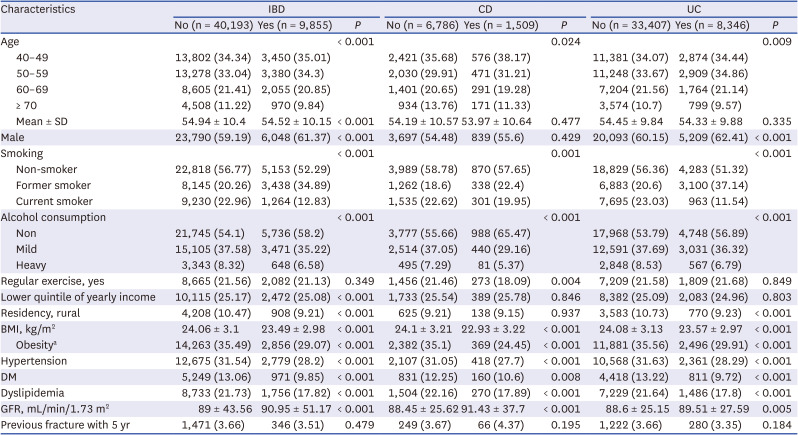
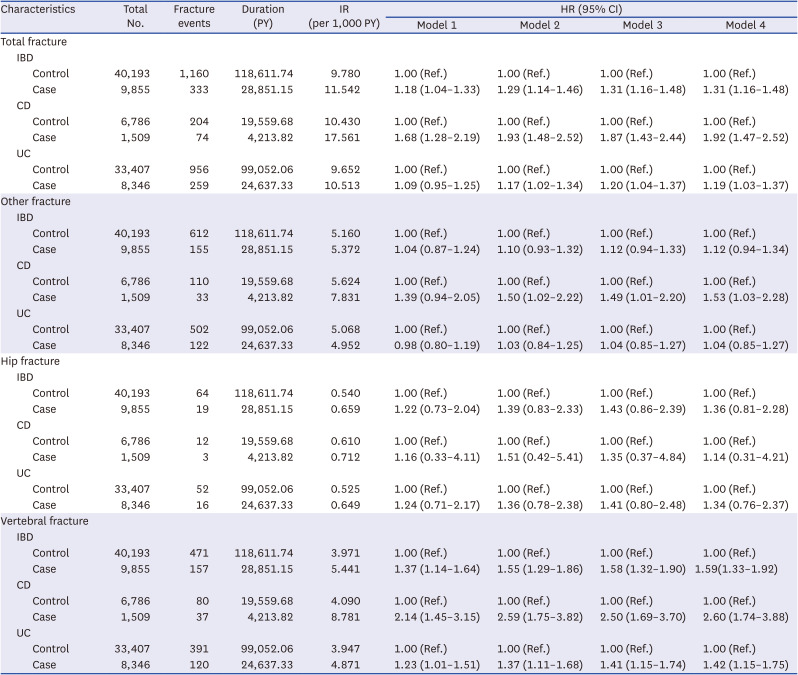
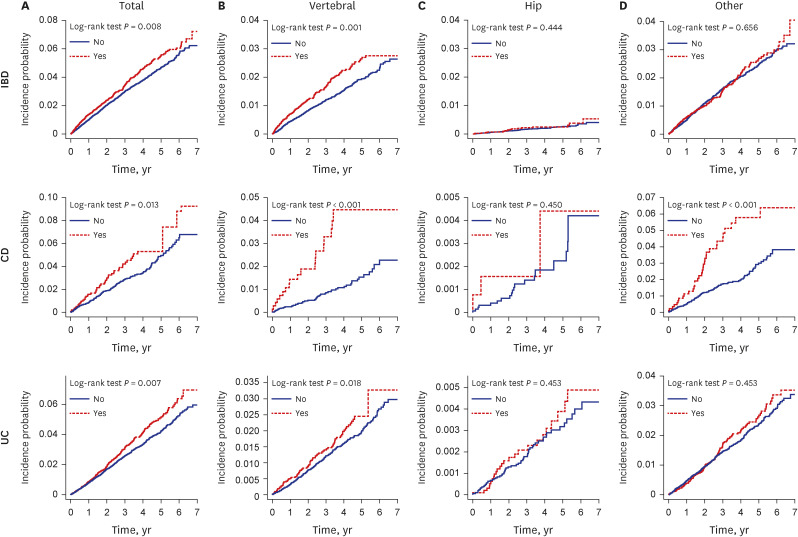
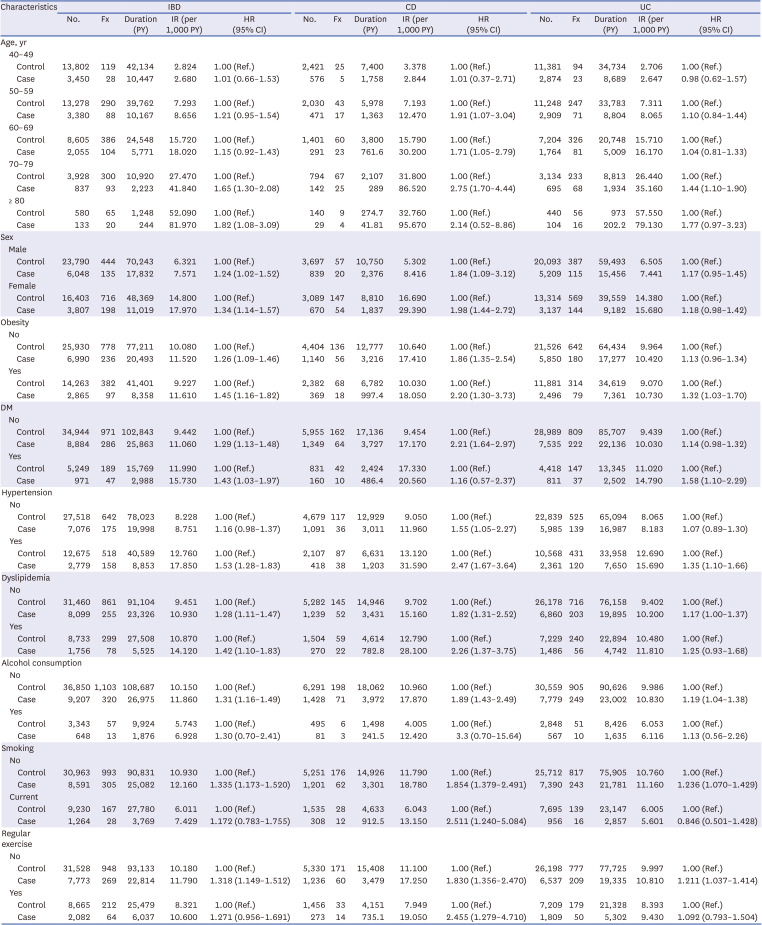




 PDF
PDF Citation
Citation Print
Print



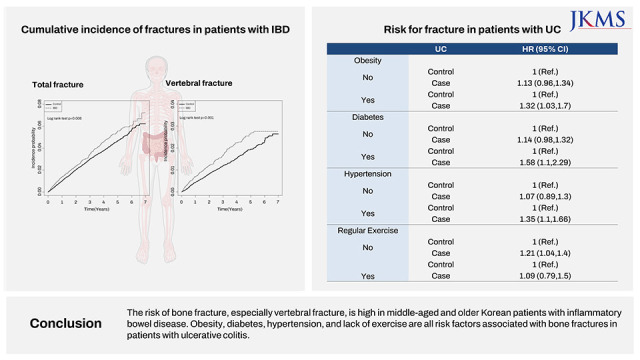
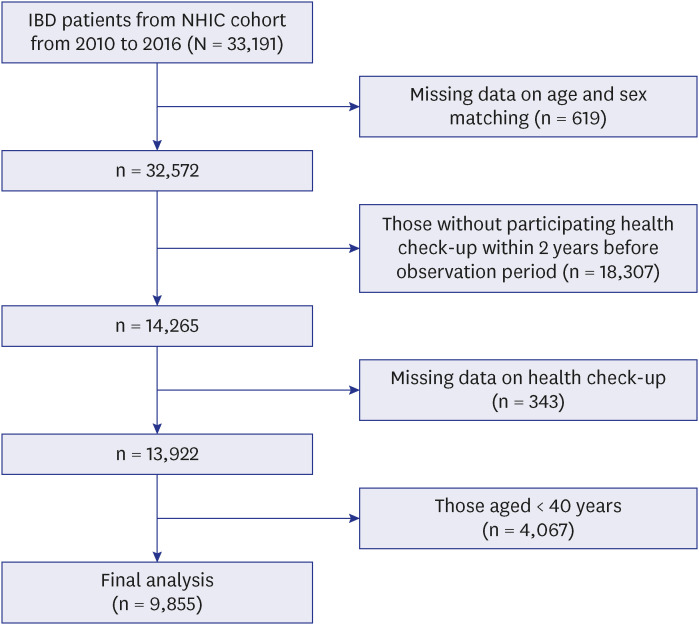
 XML Download
XML Download